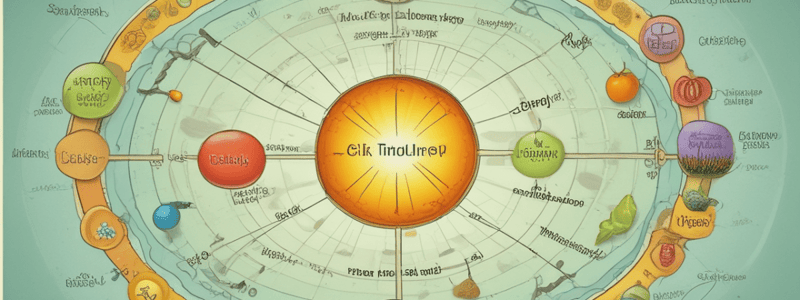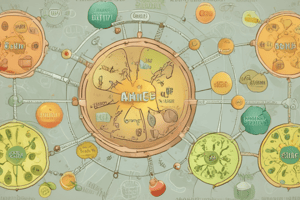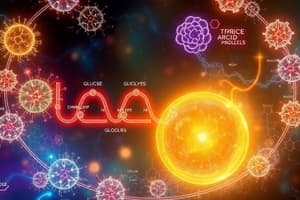Podcast
Questions and Answers
What drives the export of protons to the intermembrane space in the mitochondria?
What drives the export of protons to the intermembrane space in the mitochondria?
- ATP synthase
- Coenzyme Q
- Proton motive force
- Electron transfer chain complexes (correct)
Which complex in the electron transport chain reduces FADH2 to FAD?
Which complex in the electron transport chain reduces FADH2 to FAD?
- Complex I
- Complex IV
- Complex III
- Complex II (correct)
What is the final electron acceptor in the electron transport chain?
What is the final electron acceptor in the electron transport chain?
- NADH
- Cytochrome C
- Oxygen (correct)
- FADH2
Which molecule is reduced when it accepts electrons and hydrogens from Coenzyme Q?
Which molecule is reduced when it accepts electrons and hydrogens from Coenzyme Q?
What is the main function of ATP synthase in oxidative phosphorylation?
What is the main function of ATP synthase in oxidative phosphorylation?
Which cofactor passes electrons and hydrogens to Complex III in the electron transport chain?
Which cofactor passes electrons and hydrogens to Complex III in the electron transport chain?
What is established as protons move back down the gradient into the matrix?
What is established as protons move back down the gradient into the matrix?
4 H+ are pumped out by which complexes during electron flow in the electron transport chain for both NADH and FADH2?
4 H+ are pumped out by which complexes during electron flow in the electron transport chain for both NADH and FADH2?
What is the main function of the tricarboxylic acid cycle (TCA cycle)?
What is the main function of the tricarboxylic acid cycle (TCA cycle)?
Which enzyme is responsible for transporting pyruvate into the mitochondrial matrix?
Which enzyme is responsible for transporting pyruvate into the mitochondrial matrix?
In the TCA cycle, what is the role of Coenzyme A (CoA) in the conversion of pyruvate to Acetyl CoA?
In the TCA cycle, what is the role of Coenzyme A (CoA) in the conversion of pyruvate to Acetyl CoA?
Which molecule is produced in oxidative decarboxylation during the conversion of pyruvate to Acetyl CoA?
Which molecule is produced in oxidative decarboxylation during the conversion of pyruvate to Acetyl CoA?
Which enzyme catalyzes the conversion of citrate to isocitrate in the TCA cycle?
Which enzyme catalyzes the conversion of citrate to isocitrate in the TCA cycle?
What is the product of the conversion of a-Ketoglutarate to succinyl-CoA?
What is the product of the conversion of a-Ketoglutarate to succinyl-CoA?
Which molecule is directly produced when succinate is converted to fumarate in the TCA cycle?
Which molecule is directly produced when succinate is converted to fumarate in the TCA cycle?
'Oxidative phosphorylation' refers to:
'Oxidative phosphorylation' refers to:
Which enzyme catalyzes the conversion of fumarate to L-Malate in the Krebs cycle?
Which enzyme catalyzes the conversion of fumarate to L-Malate in the Krebs cycle?
In the Krebs cycle, which enzyme catalyzes the conversion of succinyl-CoA to succinate?
In the Krebs cycle, which enzyme catalyzes the conversion of succinyl-CoA to succinate?
What is the final product of the reaction catalyzed by malate dehydrogenase in the Krebs cycle?
What is the final product of the reaction catalyzed by malate dehydrogenase in the Krebs cycle?
Which molecule is produced as a result of the oxidative decarboxylation of α-Ketoglutarate in the Krebs cycle?
Which molecule is produced as a result of the oxidative decarboxylation of α-Ketoglutarate in the Krebs cycle?
Which complex is responsible for the transfer of electrons to oxygen during oxidative phosphorylation?
Which complex is responsible for the transfer of electrons to oxygen during oxidative phosphorylation?
In the electron transport chain, which complex pumps protons across the inner mitochondrial membrane?
In the electron transport chain, which complex pumps protons across the inner mitochondrial membrane?
Which molecule is NOT directly involved in ATP synthesis during oxidative phosphorylation?
Which molecule is NOT directly involved in ATP synthesis during oxidative phosphorylation?
What is the role of succinate dehydrogenase in the Krebs cycle?
What is the role of succinate dehydrogenase in the Krebs cycle?
Which enzyme is responsible for converting pyruvate to acetyl CoA before it enters the Krebs cycle?
Which enzyme is responsible for converting pyruvate to acetyl CoA before it enters the Krebs cycle?
What are the key redox co-factors involved in the tricarboxylic acid cycle (TCA cycle)?
What are the key redox co-factors involved in the tricarboxylic acid cycle (TCA cycle)?
Describe the process that occurs when acetate within pyruvate is converted into Acetyl CoA.
Describe the process that occurs when acetate within pyruvate is converted into Acetyl CoA.
How is pyruvate transported into the mitochondrial matrix before entering the TCA cycle?
How is pyruvate transported into the mitochondrial matrix before entering the TCA cycle?
Which molecule is produced when a-Ketoglutarate is converted into Succinyl-CoA?
Which molecule is produced when a-Ketoglutarate is converted into Succinyl-CoA?
What is the role of Succinate dehydrogenase in the TCA cycle?
What is the role of Succinate dehydrogenase in the TCA cycle?
Which molecule is directly produced when Acetyl CoA reacts with oxalacetate?
Which molecule is directly produced when Acetyl CoA reacts with oxalacetate?
What is the final product of the conversion of Isocitrate to a-Ketoglutarate?
What is the final product of the conversion of Isocitrate to a-Ketoglutarate?
Which molecule is used to activate Succinyl-CoA before it is converted into succinate?
Which molecule is used to activate Succinyl-CoA before it is converted into succinate?
What drives the production of GTP during the conversion of Succinyl-CoA to succinate?
What drives the production of GTP during the conversion of Succinyl-CoA to succinate?
Which enzyme is responsible for converting Citrate to isocitrate in the TCA cycle?
Which enzyme is responsible for converting Citrate to isocitrate in the TCA cycle?
NADH is produced when Succinyl-CoA is converted to succinate in the TCA cycle.
NADH is produced when Succinyl-CoA is converted to succinate in the TCA cycle.
FADH2 is directly involved in the production of GTP during the TCA cycle.
FADH2 is directly involved in the production of GTP during the TCA cycle.
ATP synthase is responsible for pumping protons across the inner mitochondrial membrane during oxidative phosphorylation.
ATP synthase is responsible for pumping protons across the inner mitochondrial membrane during oxidative phosphorylation.
Ion gradients play a role in driving the export of protons to the intermembrane space in the mitochondria.
Ion gradients play a role in driving the export of protons to the intermembrane space in the mitochondria.
4 H+ are pumped out by Complex I during electron flow in the electron transport chain.
4 H+ are pumped out by Complex I during electron flow in the electron transport chain.
Flashcards are hidden until you start studying
Study Notes
Tricarboxylic Acid (TCA) Cycle
- Also known as Krebs cycle or citric acid cycle
- Degradation products of carbohydrates, lipids, and amino acids are fed into the TCA cycle to release energy
- TCA cycle has both catabolic and anabolic functions (amphibolic)
Steps of TCA Cycle
- Acetyl CoA reacts with oxalacetate to produce citrate (citrate synthase)
- Citrate is converted to isocitrate (aconitase) and H2O is released
- Isocitrate is converted to α-Ketoglutarate (IDH) and NAD+ is reduced to NADH, CO2 is produced
- α-Ketoglutarate is converted into Succinyl-CoA (α-Ketoglutarate dehydrogenase) and NADH is produced
- Succinyl-CoA is converted to succinate (succinate thiokinase) and GTP is produced
- Succinate is converted to fumarate (succinate dehydrogenase) and FADH2 is produced
- Fumarate is converted to L-Malate (fumarase)
- L-Malate is converted back to oxaloacetate (malate dehydrogenase) and NADH is produced
Electron Transport Chain (ETC)
- Electrons from NADH and FADH2 flow through complexes in the inner mitochondrial membrane
- Proton gradient is established as protons move back down the gradient into the matrix
- Proton motive force is used by ATP synthase to make ATP
- Ion gradient is used to produce energy (chemiosmotic theory)
ETC Complexes
- NADH passes electrons to complex 1
- FADH2 passes electrons to complex 2
- Complex 1 and 2 pass electrons to CoQ
- CoQ passes electrons to complex 3
- Complex 3 passes electrons to cytochrome C
- Cytochrome C passes electrons to complex 4
- In complex 4, water is formed as oxygen is reduced
Other Key Points
- Oxidation: gain of oxygen, loss of H+ and e-
- Reduction: loss of oxygen, gain of H+ and e-
- NAD+ and FAD are key redox co-factors
- Link from glycolysis to TCA cycle is Pyruvate dehydrogenase (PDH)
- Pyruvate must be transported into mitochondrial matrix by pyruvate translocase
- Acetate group is slightly more oxidised, therefore H+ are taken and NAD+ is reduced to NADH+ (oxidative decarboxylation)
Studying That Suits You
Use AI to generate personalized quizzes and flashcards to suit your learning preferences.




